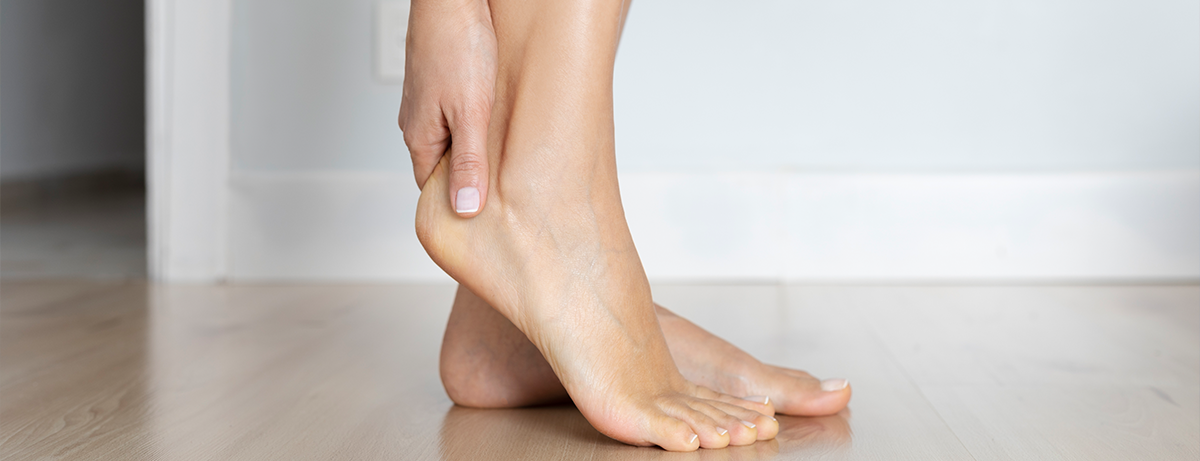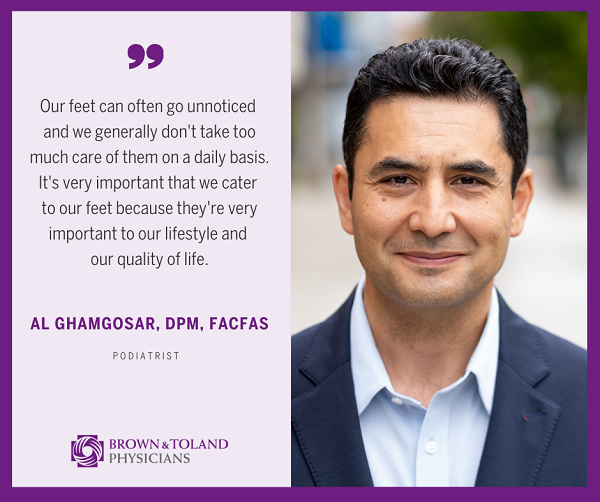Q&A: Al Ghamgosar, DPM

Brown & Toland podiatrist Al Ghamgosar, DPM, is a board-certified foot and ankle surgeon who treats the full range of foot and ankle conditions at Peninsula Foot & Ankle Center in San Mateo
Can you give a brief definition of what a podiatrist is?
A podiatrist is a physician who has a license to practice medicine and it’s the type of medicine that deals with foot and ankles problems. Most podiatrists are board certified by either the American College of Foot and Ankle Surgeons or there are several other specialty boards that certify a majority of the podiatrists that hold a licensure.
What are the most frequent symptoms that your patients are experiencing when they come in to see you?
Here in our practice, we encounter multiple conditions, of course, but among the most common we see are heel pain, foot-ankle fractures and diabetic foot complications. We also see deformities of the foot and ankle – in adults and children — including hammer toe deformities, bunion deformities.
Also, we see athletes with ankle sprains or ankle conditions and in the elderly population we see a lot of ulcerations or numb feet, pain in their feet or arthritis.
Is there an epidemic of heel pain in the U.S.? What is causing it? How is it treated?
Yes, with the COVID-19 pandemic, many people are exercising more and also walking barefoot all day, every day. Walking without any kind of an arch support, or in ill-fitting footwear, can strain the arch of the foot and cause heel pain. Called plantar fasciitis, this condition involves inflammation of a thick band of tissue that runs across the bottom of your foot and connects your heel bone to your toes. It typically causes a stabbing pain in the bottom of your foot near the heel.
The increase in obesity that we have seen in the United States is also a factor – basically, just bearing extra weight on your feet can lead to heel pain.
Treatment of plantar fasciitis usually involves some combination of stretching and strengthening exercises, orthotics and injections – rarely surgery.
I’ve heard if you are a person who has diabetes, getting in to see a foot specialist such as a podiatrist is absolutely critical for the maintenance of your health. Am I right about that? And if so, why?
Yes, you are. It’s absolutely critical because sometimes we discover other conditions that are associated with the diabetes that the patient may have been unaware of.
For example, diabetes is a condition that affects the small blood vessels or the capillary especially in the lower extremities. And those same capillaries are the ones that feed the nerve endings of our feet. In diabetics, these nerve endings can start to die off from lack of oxygenation or an increase in blood sugar levels. When this happens, the patient can start to suffer from what is known as diabetic neuropathy where they start to lose feeling in their feet. When this happens, they can suffer breaks in the skin surface because of the lack of feeling, or they can sustain a burn injury in their feet without knowing it.
People with diabetes may also develop poor circulation. As circulation slows down, blood moves more slowly, which makes it more difficult for the body to deliver nutrients to wounds. As a result, injuries heal slowly, or may not heal at all.
Is podiatry experiencing the same kind of diagnostic and treatment advancements as other specialties? If so, what would be a great example of that in your own office?
Definitely. In our practice we have digital X-rays and musculoskeletal ultrasound onsite. We also have in-office fluoroscopy, an imaging technique that allows us to view internal images of the foot and ankle in real-time, enabling us to assess joints and their motions from almost any angle. Because of these resources, we rarely have to refer patients out for imaging or other tests.
What can we do to just take better care of our feet?
It’s interesting that you ask that because our feet can often go unnoticed and we generally don’t take too much care of them on a daily basis. It’s very important that we cater to our feet because they’re very important to our lifestyle and our quality of life.
The main thing that we suggest to our patients is to inspect your feet daily, keep them moisturized and stretch your calf muscles at least once a day. Avoid going barefoot and always wear foot gear with adequate support. if you experience unusual feelings or pain or even start to see your feet changing appearance, visit a podiatrist or foot and ankle specialist for a consult as soon as possible. As with most medical situations, early detection is often the key.

MEDICAL DISCLAIMER: The content of this Website or Blog is not intended to be a substitute for professional medical advice, diagnosis, or treatment. Always seek the advice of your physician or other qualified health provider with any questions you may have regarding a medical condition. Never disregard professional medical advice or delay in seeking it because of something you have read on this Website or Blog.
If you think you may have a medical emergency, call 911 immediately, call your doctor, or go to the emergency room/urgent care.
